|
|
|
Sort Order |
|
|
|
Items / Page
|
|
|
|
|
|
|
| Srl | Item |
| 1 |
ID:
188375
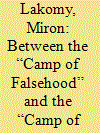

|
|
|
|
|
| Summary/Abstract |
This paper attempts to fill the gap in research and contribute to the academic debate on the online magazines of Daesh. Its primary objective is to identify and understand propaganda devices, which were exploited by the editors of “Dabiq” to influence its readers. In order to do this, the study utilized a classic framework of propaganda devices elaborated by the American Institute for Propaganda Analysis, which consists of seven methods: name-calling, glittering generalities, transfer, testimonial, card-stacking, plain folks, and bandwagon.
|
|
|
|
|
|
|
|
|
|
|
|
|
|
|
|
| 2 |
ID:
148616


|
|
|
| 3 |
ID:
166670
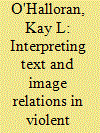

|
|
|
|
|
| Summary/Abstract |
This article presents a mixed methods approach for analysing text and image relations in violent extremist discourse. The approach involves integrating multimodal discourse analysis with data mining and information visualisation, resulting in theoretically informed empirical techniques for automated analysis of text and image relations in large datasets. The approach is illustrated by a study which aims to analyse how violent extremist groups use language and images to legitimise their views, incite violence, and influence recruits in online propaganda materials, and how the images from these materials are re-used in different media platforms in ways that support and resist violent extremism. The approach developed in this article contributes to what promises to be one of the key areas of research in the coming decades: namely the interdisciplinary study of big (digital) datasets of human discourse, and the implications of this for terrorism analysis and research.
|
|
|
|
|
|
|
|
|
|
|
|
|
|
|
|
| 4 |
ID:
188054
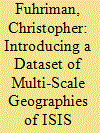

|
|
|
|
|
| Summary/Abstract |
This research proposes a methodology for extracting and analyzing geographical perspectives of terrorists and insurgents from online textual media. The information age has afforded organizations platforms that can be used to control their own media messages. Given that power, terrorist groups are able to create customized messages and define themselves in their own eyes on an international scale, often generating widespread sympathies and increased popularity. Within their online messaging, important information is provided that can potentially unveil geopolitical strategies. A mixed-method approach comprised of computer-aided content analysis, manual content analysis, and cartographic visualization is applied to ISIS’s Dabiq magazine as a case study to demonstrate the utility of this methodology. This research highlights the importance of considering the territoriality of terror groups and movements in geohistorical and present-day contexts.
|
|
|
|
|
|
|
|
|
|
|
|
|
|
|
|
| 5 |
ID:
171142
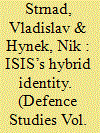

|
|
|
|
|
| Summary/Abstract |
This paper analyses the means, degree, and strategic significance of the Islamic State’s (ISIS) self-representation simultaneously as a state-like entity and a terrorist organisation. We explore how ISIS strategically used the content of its propagandist magazine Dabiq to spin its dual – or hybrid – identity, with the aim of broadening its propagandist reach. ISIS’s discursive crossfading between an aspiring, state-like territorial actor and a networked, terrorist group was the central part of its ability to mesmerise multiple audiences simultaneously. The hybrid self-representation is first contextualised vis-à-vis existing academic analyses of ISIS’s magazine Dabiq and its depiction of ISIS. Then we discuss our original thematic analysis of ISIS’s narrative features and dynamics across all existing Dabiq issues. Through abduction, we identified six themes: three presenting ISIS as a state and three as a terrorist organisation. Subsequent triangulation of these themes offers a novel contribution to the academic literature and allows us to show how ISIS attempted to maintain a state-like image to increase its radicalisation potential.
|
|
|
|
|
|
|
|
|
|
|
|
|
|
|
|
| 6 |
ID:
142530
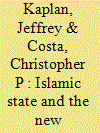

|
|
|
|
|
| Summary/Abstract |
This article focuses on the apocalyptic zeitgeist of the Islamic State through the lens of what we call the New Tribalism. It finds that IS emerged from the Al Qaeda (AQ) milieu, but soon split with AQ as the messianic excitement surrounding Al-Baghdadi and his teachings grew. In common with previous millennial/messianic movements in all three “Peoples of the Book”—Judaism, Christianity, and Islam—IS soon evolved beyond the laws of the normative faith (antinomianism). We hold that for this reason, despite its claims of faith and fealty, IS has left the Islamic Umah behind, becoming a malign sectarian group of its own whose dynamism and successes are attracting a global audience and support from Muslims in almost every country. This helps to explain such abhorrent practices as forced conversion, sexual servitude, the destruction of historic artifacts, and mass executions. We find that the American invasion of Iraq was the vital first step in a series of events, which gave birth to IS. A thorough review of IS history and political culture traces these historic moments in time.
|
|
|
|
|
|
|
|
|
|
|
|
|
|
|
|
| 7 |
ID:
175735
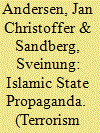

|
|
|
|
|
| Summary/Abstract |
The Islamic State (IS) has become notorious for violent, brutal actions and the presentation of these actions in social and mainstream media. Excessive violence creates a spectacle for the news media. However, IS propaganda also emphasizes its role in state building and its engagement in social and welfare work. This twofold propaganda enables the mobilization of different audiences, but it also sends conflicting messages about the organization. In this article, we study the e-magazine Dabiq, emphasizing its methods of gaining support and attempting to recruit Western participants to violent jihadism. We use theories of social movement and subculture to reveal some of the underlying tensions in IS’s communicative strategies. The analysis first identifies how IS frames its propaganda, attempting to mobilize widespread support. Then, it highlights another dimension of IS’s rhetoric: provocations, the creation of sensationalist spectacles of violence and links to excitement seeking, stardom, and popular culture. We conclude that combining general anti-Western rhetoric and religious imagery with extraordinary depictions of violence has been both a strength and flaw in the organization’s propaganda.
|
|
|
|
|
|
|
|
|
|
|
|
|
|
|
|
| 8 |
ID:
155437
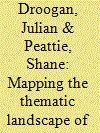

|
|
|
|
|
| Summary/Abstract |
This article presents a thematic network analysis of Dabiq—a prominent English-language e-magazine produced by the Islamic State. Through formal qualitative analysis, the article examines the e-magazine’s first 13 issues in order to better understand its structure, evolution and intended audiences. In terms of structure, thematic network analysis provides a comprehensive and holistic understanding of Dabiq’s themes, identifying a range of concerns that are broader and more complex than is often supposed by academic and professional commentators. In terms of evolution, this analysis reveals a thematic landscape that has demonstrated considerable dynamism over four distinct phases throughout the magazine’s publication. In terms of understanding audiences, it is argued that Dabiq has been particularly engaged with the manipulation of group-level identities in an apparent attempt to garner support from global audiences. Themes related to allegiance, the group’s strengths and victories, and territorial expansion all feature consistently and prominently. They seek to create an in-group identity centred on victory, and to frame the Islamic State’s expansion and successes as a group achievement on behalf of Islam itself. Additionally, Dabiq provides the Islamic State with an opportunity to justify its actions and its religious authenticity to a broader Muslim audience, and thus provide the Islamic State with legitimacy beyond its borders. Recognising these thematic dynamics will be important for those engaged in counter-messaging and the development of counternarratives.
|
|
|
|
|
|
|
|
|
|
|
|
|
|
|
|
| 9 |
ID:
166660
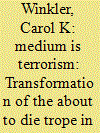

|
|
|
|
|
| Summary/Abstract |
Daesh’s ability to successfully recruit foreign fighters from more than one hundred countries worldwide raises the importance of understanding the group’s strategic media campaign. Recognizing that visual images, in particular, often increase viewers’ attention, recall, and emotional response, this study of Daesh’s official magazine, Dabiq, moves beyond earlier studies primarily focused on the magazine’s textual content to analyze the group’s visual communication strategy. This study’s content analysis of the 1,144 images appearing in the magazine’s first twelve issues reveals how Dabiq has relied extensively on a historic American media trope, the about to die image, to bolster image recirculation over time. This essay examines both the form and content of Dabiq’s use of three about to die image types as they have evolved across the twelve issues. Rather than seek to win the “hearts and minds” of the Muslim public, Dabiq’s use of about to die images transforms the online medium into terrorism in ways that have lasting implications for the global culture.
|
|
|
|
|
|
|
|
|
|
|
|
|
|
|
|
| 10 |
ID:
178939


|
|
|
|
|
| Summary/Abstract |
This article establishes that visual displays of sovereignty were central to the escalation and projected legitimacy of a violent non-state actor. Contrary to conventional perspectives, it details that the unprecedented appeal of the so-called Islamic State was tied to a visual projection of statehood. Through an innovative methodology, this study conducts a qualitative, affordance-driven analysis of the global visual politics of Dabiq. It details how photographs taken by Islamic State militants and downloaded from a variety of sources online were strategically utilized as “evidence” of the constitutive criteria of statehood: of a permanent population, a defined territory, a government, and the capacity to enter into relations with other states. It demonstrates that this violent non-state actor utilized the affordances of digital visualizing technologies in order to position itself as a viable and competitive alternative to existing nation-states—as both a destination for migration and a legitimate threat to the established political order. This realization has implications for terrorism studies as well as for the visual politics of non-state actors operating in an era of intense mediatization.
|
|
|
|
|
|
|
|
|
|
|
|
|
|
|
|
| 11 |
ID:
156154
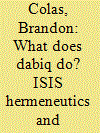

|
|
|
|
|
| Summary/Abstract |
The Islamic State of Iraq and Syria (ISIS)'s flagship English-language magazine, Dabiq, is a puzzle. The magazine is not, despite appearances, primarily designed for direct recruiting efforts or inciting violence against the West. In fact, the primary audiences of Dabiq are English-speaking second generation Muslims or converts, Western policymakers, and a third group of current or would-be members of ISIS who are not integrating with the organization itself. The third audience—those members who are failing to function within the organization—is strange to include in an English-language magazine. Why publish organizational weaknesses, in English? One possibility for this puzzle is that the fundamentalist hermeneutics of ISIS is reflected in their own media efforts. One of the assumptions that ISIS holds about their sacred texts is that each text carries a single meaning that reflects the author's original intent. There might be multiple applications of that intent, but each text can only have one intent, and therefore one meaning. Following this logic, a message meant for one person is unlikely to be of utility for another, and so this may be why ISIS exposes their weaknesses as part of the process of correcting their own members.
|
|
|
|
|
|
|
|
|
|
|
|
|
|
|
|
|
|
|
|
|